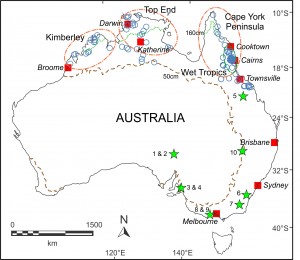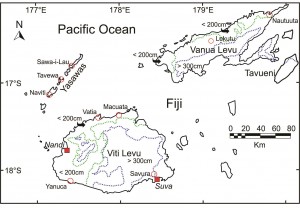Leaf physiognomy and climate
PI, David R. Greenwood
Current projects:
- Sites across northern Australia are being assessed (working with David Steart – Latrobe University, Melbourne, Australia – and others) to analyze the climatic and other ecological controls on the leaf physiognomy (i.e., size, shape) of tropical Australian vine thicket (monsoonal) sites and tropical rainforest sites, building on prior research by Greenwood (e.g., Wilf et al. 1998, Greenwood et al. 2004, Greenwood 2007 and earlier papers).
- A paper in preparation (July 2017; see map below) based on analysis of 101 sites from northern Australia and Fiji shows leaf size is strongly correlated with seasonal precipitation in monsoonal deciduous woodlands, but that leaf size is somewhat fixed in ever-wet high rainfall evergreen broadleaf forests.
 Map of Australia showing 50 cm isohyet, and location of forest sites with tree and shrub census data used for leaf physiognomy study. Eocene to Miocene fossils sites analyzed shown as green stars. |
 Map of Fiji showing location of study sites and of the major annual rainfall isohyets influencing vegetation type (<200 cm/yr, >300 cm/yr). |
- Leaf physiognomy in tropical seasonal forests – with my former PhD student David Steart and others, looking at the climatic factors which control leaf physiognomy in native forests in Fiji and South Africa.
Past projects:
- Examining the putative relationship between dicot leaf stomatal frequency and atmospheric CO2 concentration for Australian broadleaved evergreen species (a potential paleo-proxy measure of pCO2; Greenwood et al. 2003; Scarr et al. 2008) – former graduate student (Mark Scarr) project at Victoria University (Melbourne). Mark Scarr was awarded his PhD in 2011.
- A former PhD student, David Steart looked at potential bias (‘taphonomy’) in the representation of different leaf types in the fossil record, using modern forest sites and laboratory experiments (e.g., Steart et al. 2009).
Relevant group publications (* = postdoc, graduate student or comparable HQP):
- Smith* RY, Greenwood DR, and Basinger JF. 2010. Estimating paleoatmospheric pCO2 during the Early Eocene Climatic Optimum from stomatal frequency of Ginkgo, Okanagan Highlands, British Columbia, Canada. Palaeogeography, Palaeoclimatology, Palaeoecology, 293(1-2): 120 – 131. doi:10.1016/j.palaeo.2010.05.006 PDF
- Steart* DC, Greenwood DR, and Boon PI. 2009. The chemical constraints upon leaf decay rates: Taphonomic implications among leaf species in Australian terrestrial and aquatic environments. Review of Palaeobotany and Palynology, 157: 358 – 374. doi:10.1016/j.revpalbo.2009.06.008
- Scarr* MJ, Greenwood DR, and Scarpaci C. 2008. Intrinsic variation associated with stomatal frequency within Victorian specimens of Acacia melanoxylon, Acmena smithii and Eucalyptus obliqua. A preliminary study: implications for palaeoclimatological reconstructions. Quaternary Australasia, 25(2): 9 – 15. PDF
- Greenwood DR. 2007. North American Eocene Leaves and Climates: From Wolfe and Dilcher to Burnham and Wilf. In: Jarzen D, Retallack G, Jarzen S & Manchester S. (Eds.) Advances in Mesozoic and Cenozoic Paleobotany: studies in celebration of David L. Dilcher and Jack A. Wolfe. Courier Forschungsinstitut Senckenberg, 258: 95 – 108. PDF
- Greenwood DR, Wilf, P, Wing SL, and Christophel DC. 2004. Paleotemperature estimates using leaf margin analysis: Is Australia different? Palaios, 19(2): 129 – 142. PDF
- Greenwood DR, Christophel DC, and Scarr* M. 2003. Leaf stomatal frequency in the Australian tropical rainforest tree, Neolitsea dealbata (Lauraceae) as a proxy measure of pCO2. Palaeogeography, Palaeoclimatology, Palaeoecology, 196: 375 – 393. DOI: 10.1016/S0031-0182(03)00465-6
- Wilf P, Wing SL, Greenwood DR, and Greenwood CL. 1998. Using fossil leaves as paleoprecipitation indicators: An Eocene example. Geology, 26(3): 203-206. doi:10.1130/0091-7613(1998)026<0203:UFLAPI>2.3.CO;2 [abstract] PDF
